Government News
Making a scene 2023-04-09
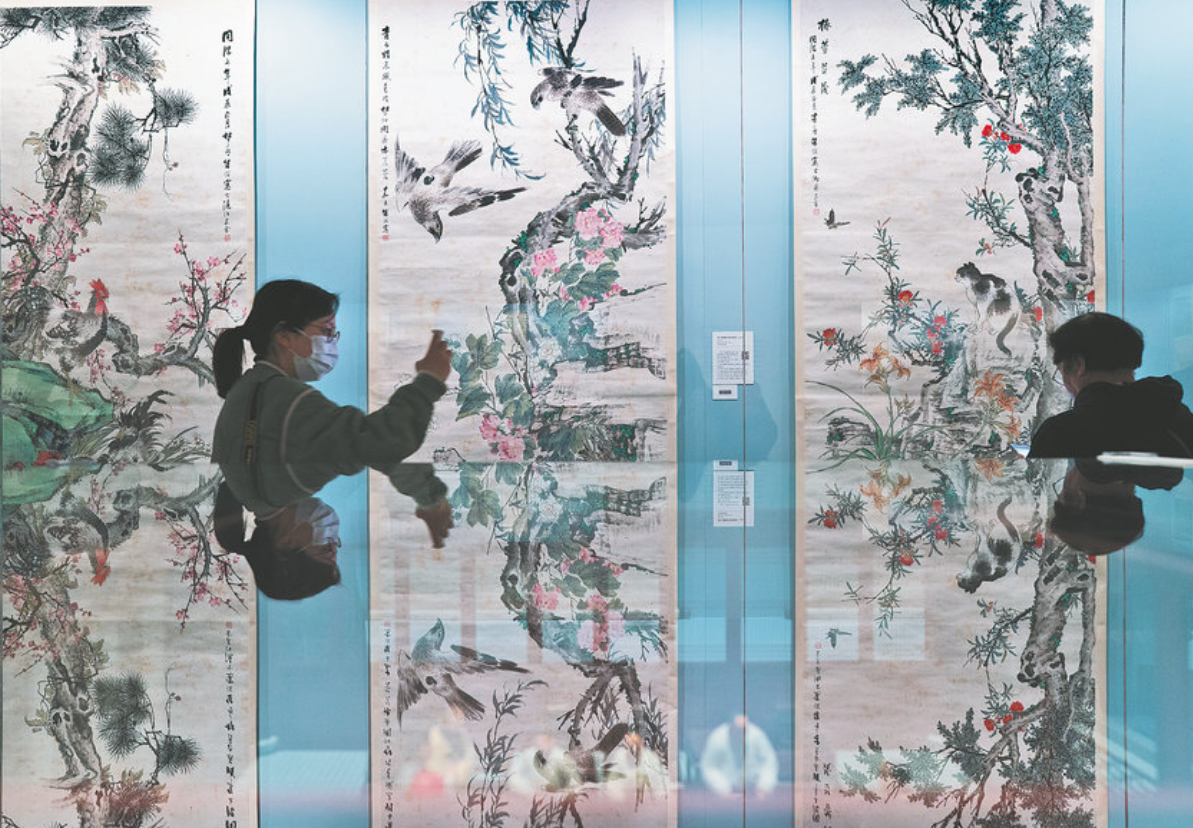
Visitors have a moment of reflection at the museum.
The Shanghai History Museum is showcasing its most treasured paintings and calligraphy works, which illustrate the distinctive Shanghai style that prospered from the mid-1800s to the early 1900s.
All the Rivers Run Into the Sea will run from March 31 to May 28, presenting altogether 95 sets of artworks, including four borrowed pieces from Zhejiang Museum, four from Anhui Museum and six from Nanjing Museum of Jiangsu province.
Sixty-four sets of the artworks are on their first public showing, according to Zhou Qunhua, director of the Shanghai History Museum. "This is the latest fruit of collaboration among the museum community members in the Yangtze River Delta."
At the exhibition opening on March 31, the Shanghai History Museum also signed strategic partnerships with the three neighboring museums respectively, pledging to further cooperation in exhibitions, protection of cultural relics, academic exchanges and personnel training.
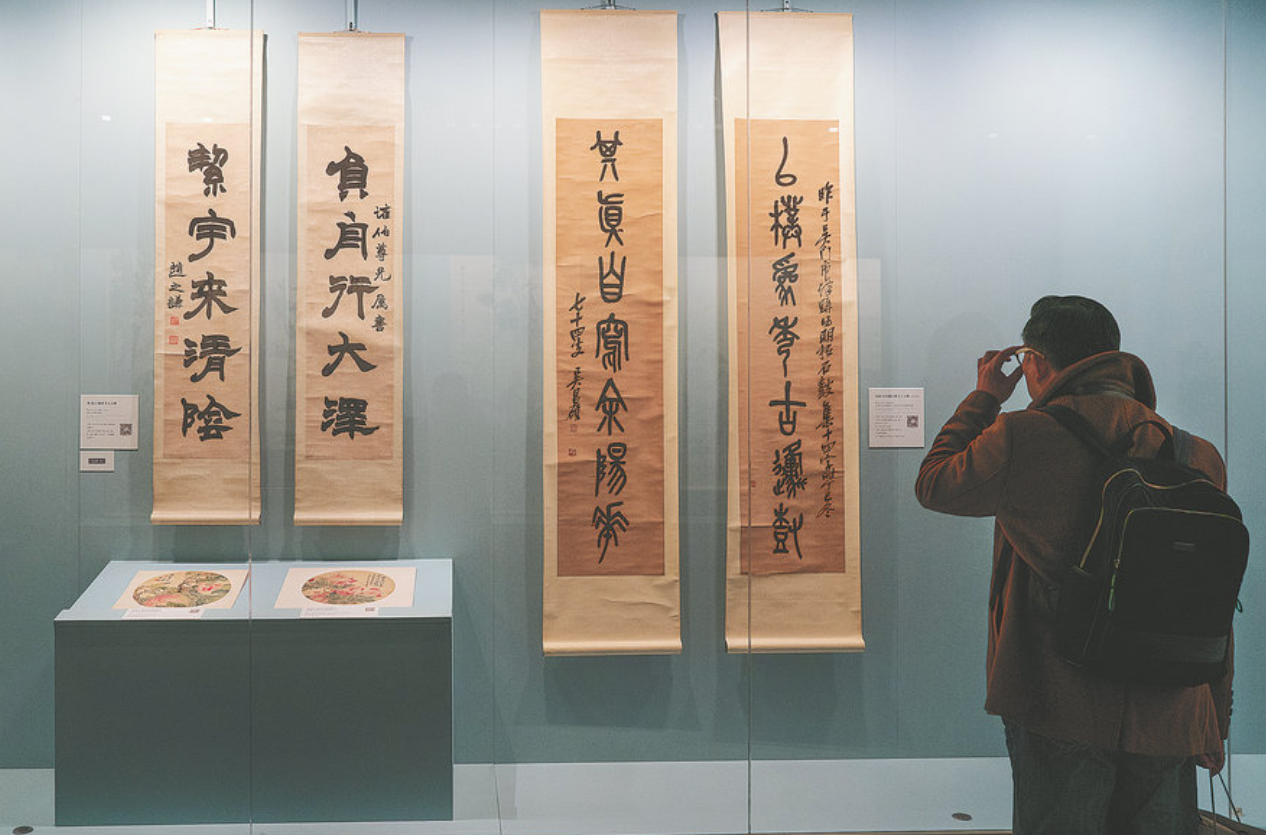
Running through May 28, the Shanghai History Museum exhibition showcases treasured paintings and calligraphy works illustrating the distinctive Shanghai style that prospered from the mid-1800s to the early 1900s.
Haipai, or Shanghai style, as a distinctive artistic branch in the Chinese art history, began to come into being when Shanghai became an open harbor in the 1860s.
Artists from nearby provinces, especially those in the Yangtze delta, gathered in Shanghai during that period to meet booming market demand for artworks. They adapted their technique and depicted subjects favored by the clients, which were often folktale scenes, legendary characters, plants and animals that symbolized good fortune.
Fan shops in town used to serve as retail outlets for individual artists at that time. On exhibition is a replica of a list that gave the standard price for painting on folding fans, hand-scrolls, hanging scrolls and so on from different artists.
Later, artists' associations were formed, publishing houses emerged and the first modern art school was founded in Shanghai. By the 1920s, art exhibitions took place frequently, and the first public display of art from all over China was held in the city in 1929.
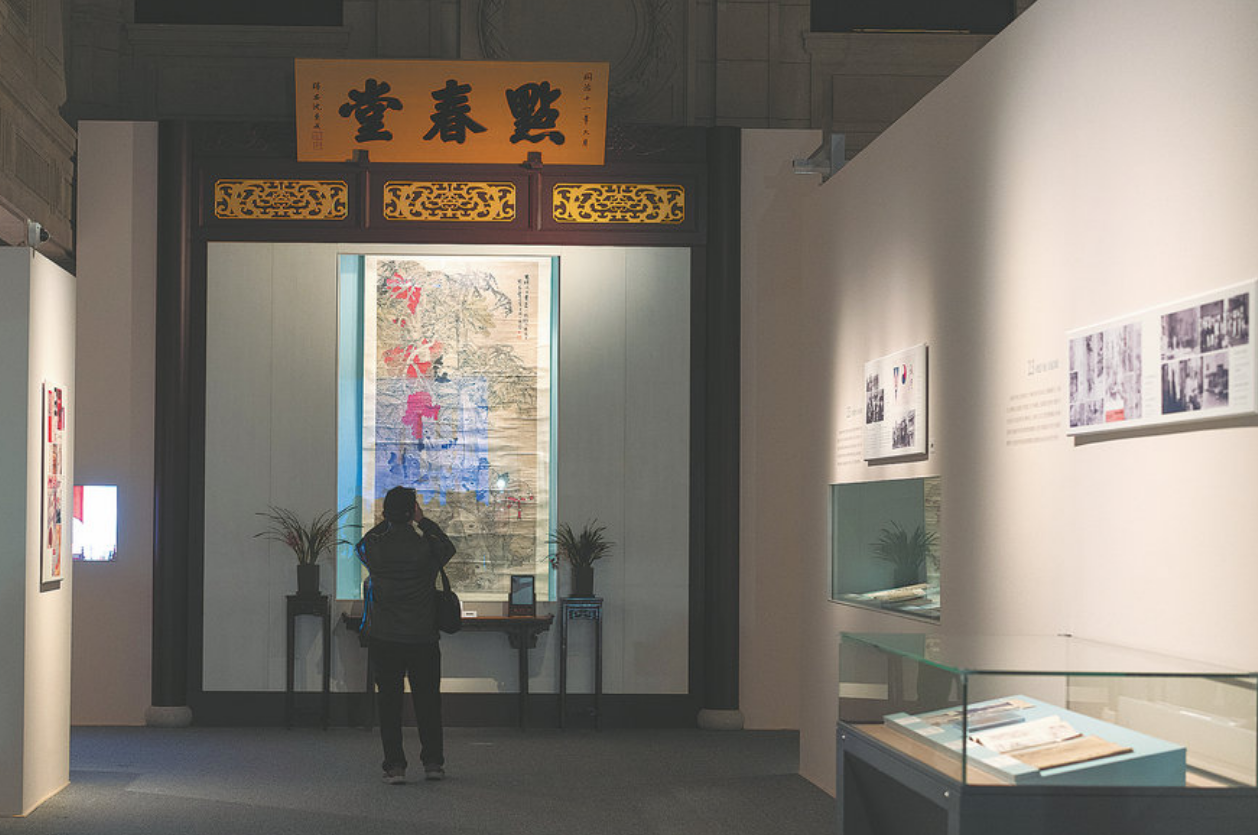
Running through May 28, the Shanghai History Museum exhibition showcases treasured paintings and calligraphy works illustrating the distinctive Shanghai style that prospered from the mid-1800s to the early 1900s.
What makes the Shanghai style stand out was its inclusiveness, diversity and innovation.
"The Shanghai-style paintings are unique, as they featured aesthetics that were close to reality and everyday life, which was in accordance with the cultural environment and public preference of the city," says Ma Genwei, deputy director of Nanjing Museum.
They introduced the traditional aesthetic for Chinese calligraphy in stone and bronze inscriptions on the depiction of plants and animals, and laid the foundation for the modern free-hand-style painting of these subjects, and reinvigorated this traditional genre of Chinese ink art, he says.
"It is fair to say that the Shanghai-style painting encapsulated the spirit of traditional Chinese art," according to Ma.
"In the particular cultural context, the Shanghai aesthetics is where the East and the West met and became intertwined, and the art creation vividly reflected the artists' unceasing quest for innovation and exploration. They have a great influence on the overall development of Chinese art later on," he says.
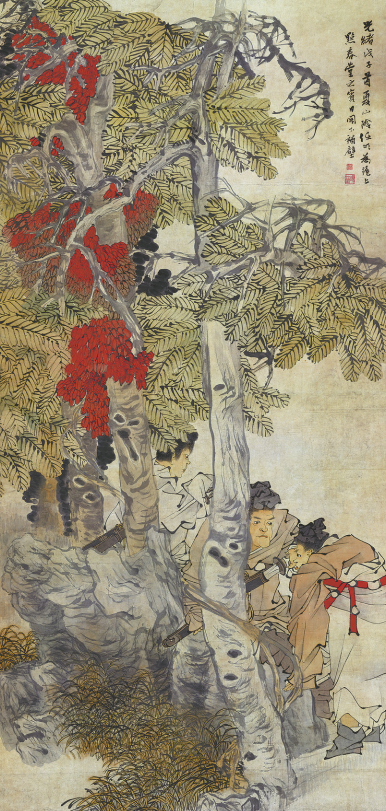
Men Observing a Sword, a 2.5-meter-long hanging scroll by Ren Yi (1840-95), is a main attraction at the ongoing exhibition of Shanghai-style artworks at the Shanghai History Museum.
A painting on exhibition is a 2.5-meter-long hanging scroll by Ren Yi (1840-95), depicting two men observing a sword. A man from Xiaoshan in Zhejiang province, Ren spent his later years in Shanghai as a professional painter.
The painting created in 1888 marks the maturity of his technique. It features an intriguing composition with two men standing stealthily behind trees, as if plotting.
The trees are so overwhelmingly tall that they add to the mysterious atmosphere. "We don't know the actual story in this picture, except that it was commissioned by the Dianchun Hall, a building near the old Chenghuang Miao (City God Temple)," according to Tang Yongyu, a researcher with the Shanghai History Museum.
Dianchun Hall was the headquarters of the Shanghai's rice and sugar trade union at that time, and in the 1950s, the painting was given to the predecessor of the Shanghai History Museum.
In 1960, it was taken over by the Shanghai Museum, where it was kept until 1993, when the Shanghai History Museum was reopened, and the painting returned to its collection. This is the second time the painting is on public exhibition since 1996, Tang says.
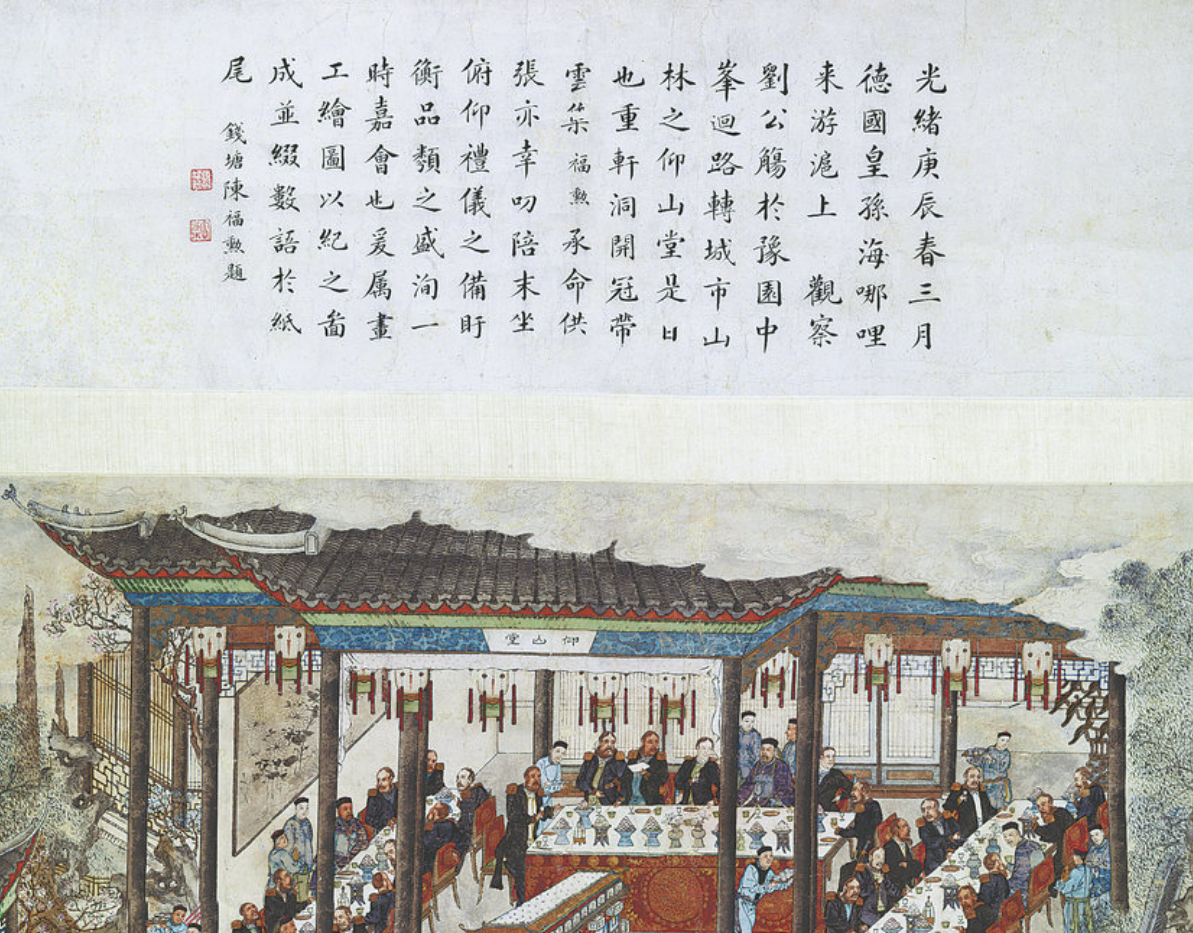
Banquet in Yu Garden by Wu Youru (1850-94) is a well-known fine-brush Chinese painting, noted especially for the contours in thin single lines and the pioneering meeting of Chinese and Western styles.
Another painting is by Wu Youru (1850-94) depicting a banquet in the Yu Garden for a visiting German prince, where Western tableware is seen alongside Chinese chopsticks. It is a fine-brush Chinese painting, where the contours were drawn accurately in thin single lines.
"Wu borrowed the techniques of his contemporary Chinese artists, and learned from his Western counterparts the process of light-and-shadow, as well as the Western perspective," Tang says, adding that Wu was a pioneer in Chinese genre painting of social life and news stories.
"In an age before photography, it took arduous concentration to have so many people portrayed in one painting," Tang points out.
With the opening of this exhibition, the Shanghai History Museum opened the outdoor space between its main building, and the West Wing. "The historical buildings are our finest exhibits," Zhou, the museum director says.
The main building of today's Shanghai History Museum was built in 1934, and used to be the former administrative office of the Shanghai Race Club.
It is classical British architecture with a 53-meter-tall clock tower on the top.
The West Wing building was built in 1928, and used to be the logistic facilities for the Race Club. Visitors can go into the courtyard without appointment to appreciate the architecture.
The exhibitions are free of charge, but online appointments must be made and registration requires a valid identification card.
If you go
All the Rivers Run Into the Sea: Joint Exhibition of Painting Masters of Shanghai Style from Jiangsu, Zhejiang, Shanghai and Anhui
March 31-May 28, 9 am-5 pm, Tuesday-Sunday.
Shanghai History Museum East Wing, 325 Nanjing Road West, Huangpu district, Shanghai.
Source: China Daily
Application Status
| 04-16 | 21315227 | Processing |
| 03-12 | 21315226 | Processing |
| 09-26 | 21315225 | Processing |
Inquiry Status
| 02-29 | 02131558 | Received |
| 03-06 | 02131557 | Received |
| 11-14 | 02131556 | Received |
FAQ
Q: Q: Is there a place where I can get...
A: A: Log on to http://touch.shio.gov....
A: A: Log on to http://touch.shio.gov....
Q: Q: What is the easiest way to set u...
A: A: 1. Log on to http://touch.shio.g...
A: A: 1. Log on to http://touch.shio.g...
Q: Where can I get an English map of S...
A: English maps of Shanghai are availa...
A: English maps of Shanghai are availa...

